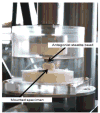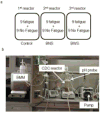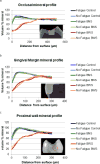Interfacial degradation of adhesive composite restorations mediated by oral biofilms and mechanical challenge in an extracted tooth model of secondary caries
- PMID: 28843960
- PMCID: PMC5783324
- DOI: 10.1016/j.jdent.2017.08.009
Interfacial degradation of adhesive composite restorations mediated by oral biofilms and mechanical challenge in an extracted tooth model of secondary caries
Abstract
Objective: To study the combined effect of simulated occlusal loading and plaque-derived biofilm on the interfacial integrity of dental composite restorations, and to explore whether the effects are modulated by the incorporation of sucrose.
Methods: MOD-class-II restorations were prepared in third molars. Half of the specimens (n=27) were subjected to 200,000 cycles of mechanical loading using an artificial oral environment (ART). Then, both groups of specimens (fatigued and non-fatigued) were divided into three subgroups for testing in CDC-reactors under the following conditions: no biofilm (Control), biofilm with no sucrose (BNS) and biofilm pulsed with sucrose (BWS). BNS and BWS reactors were incubated with a multispecies inoculum from a single plaque donor whereas the control reactor was not. The BWS reactor was pulsed with sucrose five times a day. The biofilm challenges were repeated sequentially for 12 weeks. pH was recorded for each run. Specimens were examined for demineralization with micro-CT and load capacity by fast fracture test.
Results: Demineralization next to the restorations was only detectable in BWS teeth. Fracture loads were significantly reduced by the concomitant presence of biofilm and sucrose, regardless of whether cyclic mechanical loading was applied. Cyclic loading reduced fracture loads under all reactor conditions, but the reduction was not statistically significant.
Conclusions: Sucrose pulsing was required to induce biofilm-mediated degradation of the adhesive interface. We have presented a comprehensive and clinically relevant model to study the effects of mechanical loading and microbial challenge on the interfacial integrity of dental restorations.
Keywords: Adhesive interface; Cyclic loading; Mechanical fatigue; Oral biofilms; Resin composite; Sucrose.
Copyright © 2017 Elsevier Ltd. All rights reserved.
Figures







Similar articles
-
A Review of Mechano-Biochemical Models for Testing Composite Restorations.J Dent Res. 2021 Sep;100(10):1030-1038. doi: 10.1177/00220345211026918. Epub 2021 Aug 7. J Dent Res. 2021. PMID: 34365857 Free PMC article. Review.
-
Degradation in the dentin-composite interface subjected to multi-species biofilm challenges.Acta Biomater. 2014 Jan;10(1):375-83. doi: 10.1016/j.actbio.2013.08.034. Epub 2013 Sep 3. Acta Biomater. 2014. PMID: 24008178 Free PMC article.
-
Bioactive glass fillers reduce bacterial penetration into marginal gaps for composite restorations.Dent Mater. 2016 Jan;32(1):73-81. doi: 10.1016/j.dental.2015.10.007. Epub 2015 Nov 24. Dent Mater. 2016. PMID: 26621028 Free PMC article.
-
Calibration of a lactic-acid model for simulating biofilm-induced degradation of the dentin-composite interface.Dent Mater. 2017 Nov;33(11):1315-1323. doi: 10.1016/j.dental.2017.08.186. Epub 2017 Sep 8. Dent Mater. 2017. PMID: 28890234 Free PMC article.
-
Proteins, pathogens, and failure at the composite-tooth interface.J Dent Res. 2014 Dec;93(12):1243-9. doi: 10.1177/0022034514550039. Epub 2014 Sep 4. J Dent Res. 2014. PMID: 25190266 Free PMC article. Review.
Cited by
-
Methacrylate Polymers With "Flipped External" Ester Groups: A Review.Front Dent Med. 2022;3:923780. doi: 10.3389/fdmed.2022.923780. Epub 2022 Jun 10. Front Dent Med. 2022. PMID: 37377937 Free PMC article.
-
A Review of Mechano-Biochemical Models for Testing Composite Restorations.J Dent Res. 2021 Sep;100(10):1030-1038. doi: 10.1177/00220345211026918. Epub 2021 Aug 7. J Dent Res. 2021. PMID: 34365857 Free PMC article. Review.
-
Impact of Thermal Aging on Marginal Adaptation in Lithium Disilicate CAD/CAM Crowns with Deep Proximal Box Elevation.Med Sci Monit. 2025 Feb 3;31:e947191. doi: 10.12659/MSM.947191. Med Sci Monit. 2025. PMID: 39895039 Free PMC article.
-
A critical analysis of research methods and experimental models to study the load capacity and clinical behaviour of the root filled teeth.Int Endod J. 2022 Apr;55 Suppl 2(Suppl 2):471-494. doi: 10.1111/iej.13722. Epub 2022 Mar 29. Int Endod J. 2022. PMID: 35263455 Free PMC article. Review.
-
In Vitro Biofilm Formation on Aryl Ketone Polymer (AKP), A New Denture Material, Compared with That on Three Traditional Dental Denture Materials.Int J Dent. 2021 Oct 26;2021:4713510. doi: 10.1155/2021/4713510. eCollection 2021. Int J Dent. 2021. PMID: 34737774 Free PMC article.
References
-
- Boaro LC, Froes-Salgado NR, Gajewski VE, Bicalho AA, Valdivia AD, Soares CJ, et al. Correlation between polymerization stress and interfacial integrity of composites restorations assessed by different in vitro tests. Dent Mater. 2014;30:984–92. - PubMed
-
- Yamamoto T, Ferracane JL, Sakaguchi RL, Swain MV. Calculation of contraction stresses in dental composites by analysis of crack propagation in the matrix surrounding a cavity. Dent Mater. 2009;25:543–50. - PubMed
-
- Yamamoto T, Nishide A, Swain MV, Ferracane JL, Sakaguchi RL, Momoi Y. Contraction stresses in dental composites adjacent to and at the bonded interface as measured by crack analysis. Acta Biomater. 2011;7:417–23. - PubMed
-
- Cenci MS, Pereira-Cenci T, Cury JA, Ten Cate JM. Relationship between gap size and dentine secondary caries formation assessed in a microcosm biofilm model. Caries Res. 2009;43:97–102. - PubMed
-
- Diercke K, Lussi A, Kersten T, Seemann R. Isolated development of inner (wall) caries like lesions in a bacterial-based in vitro model. Clin Oral Investig. 2009;13:439–44. - PubMed
MeSH terms
Substances
Grants and funding
LinkOut - more resources
Full Text Sources
Other Literature Sources
Medical

